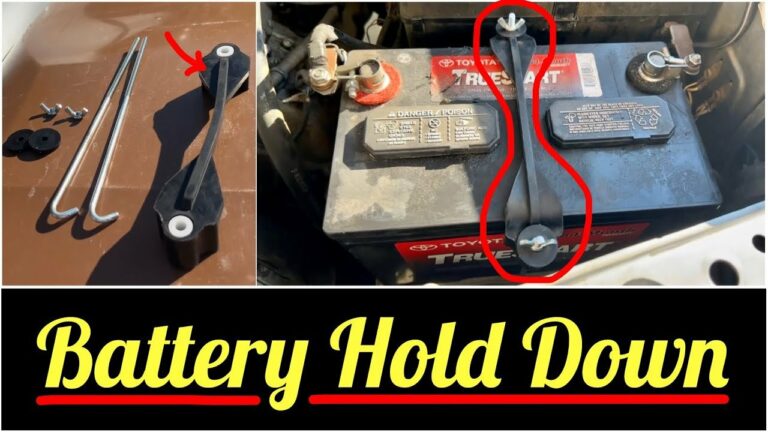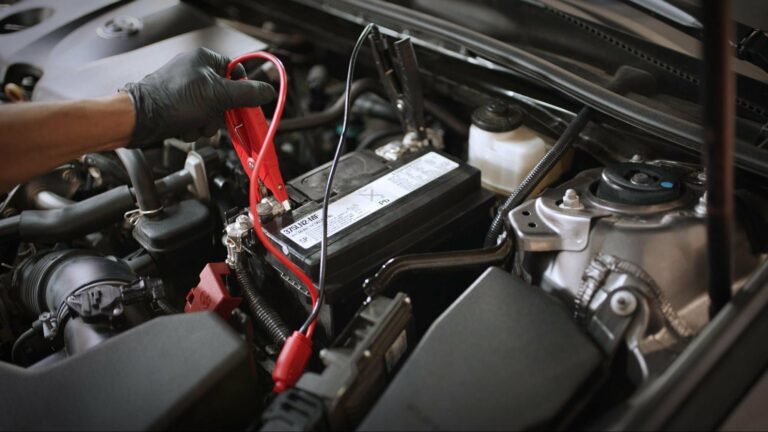Ultimate Guide: Charging A Car Battery With Solar-Powered Trickle Charger
Have you ever found yourself in a situation where your car battery is dead and you’re nowhere near a power source? It can be incredibly frustrating and inconvenient. But fear not, there is a solution! You can charge your car battery using a solar-powered trickle charger. Yes, you read that right – harnessing the power of the sun to revive your dead battery. In this article, we will guide you through the simple steps of how to charge a car battery using a solar-powered trickle charger. Let’s get started!
How to Charge a Car Battery Using a Solar-Powered Trickle Charger?
Charging a car battery using a solar-powered trickle charger is not only an eco-friendly and cost-effective solution but also a convenient way to keep your battery charged, especially if your vehicle is not used frequently or is parked for extended periods of time. In this article, we will guide you through the process of using a solar-powered trickle charger effectively to charge your car battery.
Section 1: Understanding Solar-Powered Trickle Chargers
Before we delve into the process, let’s first understand what a solar-powered trickle charger is and how it works.
What is a Solar-Powered Trickle Charger?
A solar-powered trickle charger is a device designed to keep your car battery charged using solar energy. It consists of a solar panel, charge controller, and connection cables. The solar panel converts sunlight into electricity, which is then regulated by the charge controller and delivered to the battery in a slow and steady manner.
How Does a Solar-Powered Trickle Charger Work?
The solar panel of a trickle charger absorbs sunlight and converts it into direct current (DC) electricity. The charge controller ensures that the electricity generated is regulated and does not exceed the battery’s capacity, preventing overcharging. The charge controller also prevents reverse current flow, ensuring that the battery doesn’t discharge back through the solar panel during low light conditions.
Section 2: Preparing for Charging
Before you begin charging your car battery with a solar-powered trickle charger, it’s important to prepare both the charger and the battery for optimal charging performance.
Check the Battery’s Condition
Ensure that the car battery is in good condition and doesn’t have any visible damage or leaks. If the battery is damaged, it’s recommended to replace it before attempting to charge it with a solar-powered trickle charger.
Clean and Secure the Solar Panel
Inspect the solar panel for any dirt, debris, or obstructions that may reduce its efficiency. Clean the surface of the solar panel with a soft cloth and ensure it is securely mounted or positioned correctly for maximum sunlight exposure.
Inspect the Connection Cables
Check the connection cables for any signs of wear or damage. Ensure that the cables are properly connected, with the positive (+) and negative (-) terminals correctly aligned between the solar panel and the charge controller.
Section 3: Connecting the Solar-Powered Trickle Charger
Now that you have prepared the charger and the battery, it’s time to connect the solar-powered trickle charger to your car battery.
Locate the Battery
Identify the location of your car battery. In most vehicles, the battery is located under the hood, but in some cases, it may be in the trunk or under a seat. Refer to your vehicle’s manual for guidance if needed.
Connect the Charge Controller
Connect the charge controller to the battery by attaching the positive (+) terminal of the charge controller to the positive (+) terminal of the battery, and the negative (-) terminal of the charge controller to the negative (-) terminal of the battery. Ensure a secure connection, but avoid overtightening.
Connect the Solar Panel
Connect the solar panel to the charge controller by plugging the connection cables into their respective ports on the controller. Again, ensure that the connection is secure.
Section 4: Positioning the Solar Panel
Proper positioning of the solar panel is crucial to maximize its exposure to sunlight and optimize charging efficiency.
Select an Ideal Location
Choose a location where the solar panel will receive the maximum amount of sunlight throughout the day. This is typically an area with direct sunlight and minimal shading, such as on the roof of your vehicle or on a nearby elevated surface.
Angle the Solar Panel
Tilt the solar panel at an angle that aligns with your geographical location and the current season. Adjusting the angle allows better absorption of sunlight, especially during low sun angles in winter or high sun angles in summer.
Use a Solar Panel Stand
If your solar panel doesn’t have a built-in stand, consider using a stand or bracket to position the panel optimally. This will help keep it steady and maintain the ideal angle for maximum sunlight exposure.
Section 5: Monitoring and Maintaining the Charging Process
It’s essential to monitor the charging process and maintain the trickle charge to ensure efficient and safe charging of your car battery.
Monitor the Charge Controller
Regularly check the charge controller’s status indicators or display, if available, to ensure that the solar panel is generating electricity and charging the battery. Most charge controllers have LED lights that indicate the charging status.
Avoid Overcharging
Solar-powered trickle chargers are designed to provide a slow and steady charge, preventing overcharging. However, it’s still important to periodically check the battery’s voltage using a multimeter or similar device to ensure it doesn’t exceed the manufacturer’s recommended level.
Maintain Regular Charging
For optimal battery health, it’s recommended to keep your solar-powered trickle charger connected to the battery whenever the vehicle is not in use for an extended period. This helps maintain a suitable charge level and extends the battery’s lifespan.
Section 6: Safety Precautions and Tips
While using a solar-powered trickle charger is generally safe, it’s essential to follow some safety precautions and tips to avoid potential hazards.
Avoid Charging in Extreme Conditions
Avoid charging the battery with a solar-powered trickle charger during extreme weather conditions such as heavy rain, snowfall, or extreme heat. These conditions can damage the charger and affect charging performance.
Disconnect the Charger Properly
When disconnecting the solar-powered trickle charger, always start by disconnecting the charger from the battery first. This prevents any potential electrical hazards or sparks.
Store the Charger Safely
When not in use, store the solar-powered trickle charger in a cool and dry place. Protect it from extreme temperatures and direct sunlight to prevent damage and ensure its longevity.
Refer to Manufacturer’s Instructions
Always refer to the manufacturer’s instructions and guidelines specific to your solar-powered trickle charger for any additional safety precautions or tips.
By following these steps and guidelines, you can effectively charge your car battery using a solar-powered trickle charger. This eco-friendly method not only helps keep your battery charged but also contributes to reducing your carbon footprint. Enjoy the convenience and benefits of solar-powered charging while maintaining the performance and longevity of your car battery.
Frequently Asked Questions
How does a solar-powered trickle charger work?
A solar-powered trickle charger works by converting sunlight into electricity through photovoltaic cells. The charger collects and stores this energy in a battery, which is then used to charge the car battery. It continuously provides a low level of power to the car battery, preventing it from discharging completely and helping to maintain its charge over time.
Can I use a solar trickle charger to charge a completely dead car battery?
While a solar trickle charger can help maintain the charge of a car battery, it may not be sufficient to charge a completely dead battery. In such cases, it is recommended to use a dedicated battery charger to provide a higher level of charging power to restore the battery’s charge. Once the battery has some charge, a solar trickle charger can then be used to maintain its charge.
How long does it take to charge a car battery using a solar-powered trickle charger?
The time it takes to charge a car battery using a solar-powered trickle charger depends on various factors such as the charger’s wattage, the amount of sunlight available, and the condition of the battery. Generally, it may take several days to a week or more to fully charge a car battery using a trickle charger. It is important to follow the manufacturer’s recommendations and consider factors that may affect charging time.
Can I use a solar-powered trickle charger on a cloudy day?
Solar trickle chargers can still work on cloudy days, although the charging efficiency may be reduced compared to bright sunny days. The charger will continue to collect energy from sunlight, albeit at a slower rate. It is important to position the charger where it can receive the maximum amount of available sunlight during cloudy days to optimize its charging capability.
What precautions should I take when using a solar-powered trickle charger?
When using a solar-powered trickle charger, it is important to follow some precautions. Ensure that the charger is compatible with your car battery and follow the manufacturer’s instructions for proper installation and usage. Maintain proper connections, ensuring the charger is securely connected to the battery. Regularly clean the solar panels to keep them free from dust and debris, which can affect their efficiency. Additionally, always place the charger in a safe and well-ventilated area away from flammable materials.
Final Thoughts
In conclusion, learning how to charge a car battery using a solar-powered trickle charger is a practical and eco-friendly solution for vehicle owners. By harnessing the power of the sun, it offers a convenient and cost-effective way to keep your car battery charged. With proper installation and maintenance, a solar-powered trickle charger can provide a steady trickle of energy to your battery, ensuring it remains in good condition and extending its lifespan. So, the next time you need to charge your car battery, consider utilizing a solar-powered trickle charger for a greener and more sustainable approach.

